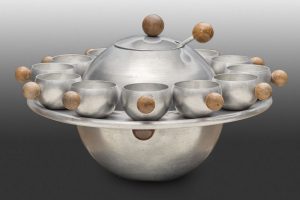
Russel Wright (American, 1904–1976), “Saturn” punch service, c. 1935, Spun aluminum with lacquered wood handles, 12 x 20 in., Museum purchase, William McDonald Boles and Eva Carol Boles Fund, 2017.200.a-.o.
Taken on its own as a visual object, this punch service in NOMA’s decorative arts collection is striking. A large aluminum sphere punch bowl centers a galaxy of spherical cups riding on a ring like Saturn’s, the repeated shapes emphasized and softened by spherical birchwood handles. At the center of a party, the punch wouldn’t even need to be spiked for this eye-catching bowl to bring joy to the gathering. Taken as part of a larger body of work, including the best-selling dinnerware of all time, Russel Wright’s “Saturn” punch service reminds us of the profound evolution in the American domestic scene at the middle of the twentieth century.
Improbably, Russel Wright (American, 1904–1976) and Mary Wright (American, 1904–1952) found great commercial success entering the home goods market during the Great Depression. In 1930 the couple introduced their line of spun aluminum serving accessories manufactured in their home, a carriage house on East 35th Street in New York City. In a 1960 article, Wright looked back on his early career saying “Aluminum was exciting for a young designer who wanted to design everything and had only a workbench and a lathe. The easy workability of the metal, its permanent integral coloring, inspired me to develop a variety of products.” This vast line of aluminum objects like “lemonade pitchers” and “pretzel bowls” were designed to take advantage of the properties of spinning aluminum, with cylinders and spheres, but they were also designed for a new purpose: informal entertaining. Lightweight, easy to maintain, and playful, the Wright’s aluminum products suggested a modern lifestyle in deep contrast to earlier traditions that equated formality with elegance.
Russel Wright is credited with the look and fabrication of his eponymous line, but his wife and business partner Mary has long gone unsung for the marketing-savvy and business acumen that led to the Wright’s lasting impact on American design. Mary Wright invented a lifestyle brand (before that term existed) around Russel’s new forms, writing pamphlets to suggest playful entertainment ideas, like “tidbit stands” for “midnight snacks.” A Christmas 1932 advertisement for an aluminum and birch “Butler Bucket” (cocktail cups concentric to an ice bucket, similar to NOMA’s punch bowl), promised that “it enables you to serve all guests in one jaunt around the room, instead of having to make half a dozen trips to and from the pantry.”
Mary Wright’s vision was compiled in the influential Guide to Easier Living, first published in 1950 and having many reprints since. The illustrated manual promises that “formality is not necessary for beauty” with tips for organizing a broom closet, simple suppers (one-pot meals), and easy entertaining (buffets). Far from superficial, Mary’s ideas are parallel to profound shifts in servant-less kitchens, movement from urban to suburban areas, and growing numbers in the American middle class. Ideas that were revolutionary in 1950, like the Wrights imagining “living room, dining room and kitchen will break through the walls that arbitrarily divide them, and become simply friendly areas of one large, gracious and beautiful room” are now ubiquitous today’s HGTV viewer seeing the American desire for “open concept” homes.
While the Wrights were prescient about how nearly every manner of American domestic life would evolve in the 20th century, none of their other products enjoyed the same enormous commercial success as the “American Modern” ceramics. This tableware line produced by Steubenville Pottery in Ohio came to define the color palette, organic feel, and playful attitude of mid-century design. When designed in 1937, its undulating forms were unconventional, but by the wave of post-War families setting up homes in the early 1950s, the biomorphic look of “American Modern” was vastly popular. With Mary’s trademark zest for evocative marketing, the line was offered in mix n’ match colors like bean brown, cantaloupe, and seafoam green. In the galleries at NOMA, you can see an “American Modern” coral celery dish and a chartreuse creamer.
“American Modern,” the best-selling dinnerware pattern of all time, was one of many Wright collaborations with companies to offer informal yet fashionable objects to suit new ideas about the American home. The Wright’s designs included textile tablecloths, glass drink and barware, metal cocktail shakers, furniture, and plastic dinnerware. All these inexpensive, mass produced designs were sympathetic to Mary Wright’s goals for simplified living outlined in her influential lifestyle manual. Starting with their experimental line of home-produced aluminum domestic goods, like NOMA’s exceptional “Saturn” punch service, Russel and Mary Wright went on to become major thought leaders in 20th-century design.
—Mel Buchanan, RosaMary Curator of Decorative Arts and Design
NOMA is committed to uniting, inspiring, and engaging diverse communities and cultures through the arts — now more than ever. You can support NOMA’s staff during these uncertain times as they work hard to produce virtual content to keep our community connected, care for our permanent collection during the museum’s closure, and prepare to reopen our doors.

